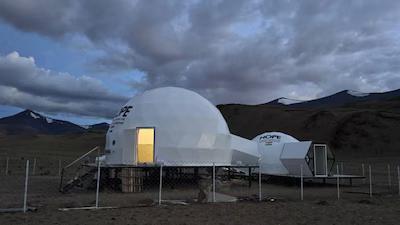
ISRO sets up station in Ladakh to simulate life on Moon & Mars
India’s space agency, ISRO, has taken a significant step towards exploring the vast expanse of space by setting up a unique station in Ladakh’s Tso Kar Valley. The Himalayan Outpost for Planetary Exploration (HOPE) is a 10-day simulation mission aimed at testing life-support systems for lunar and Martian missions. This bold initiative marks a new era in India’s space exploration journey.
Located at an altitude of 4,500 meters above sea level, the Tso Kar Valley was chosen for its extreme environment, which bears a striking resemblance to the Martian landscape. The valley is characterized by high UV radiation, low atmospheric pressure, extreme cold, and saline permafrost, making it an ideal location to simulate the harsh conditions of Mars.
The HOPE station will be operational from August 1 to 10, with two crew members undertaking various tests and experiments to assess the feasibility of sustaining life on the red planet. The crew will be equipped with specialized equipment and clothing to withstand the harsh conditions, and will be conducting experiments to test the effectiveness of life-support systems, including air, water, and food supplies.
The primary objective of the HOPE mission is to test the endurance of humans in a Martian-like environment. The station is equipped with state-of-the-art equipment and facilities to simulate the conditions of Mars, including a habitat, life-support systems, and communication equipment. The crew will also conduct scientific experiments to study the effects of prolonged exposure to Martian conditions on the human body.
The HOPE mission is a significant step towards India’s ambitious plans to send humans to Mars in the near future. The country has been actively involved in space exploration, with several successful missions to the Moon and Mars. The HOPE mission is a vital component of ISRO’s lunar and Martian exploration program, which aims to establish a human settlement on the red planet by the mid-2020s.
The choice of Ladakh as the location for the HOPE station is not coincidental. The region’s extreme climate and geography make it an ideal location for testing the endurance of humans in space-like conditions. The valley’s high altitude and low atmospheric pressure are similar to those found on Mars, making it an ideal location for simulating the Martian environment.
The HOPE mission is a testament to India’s growing capabilities in space exploration and its commitment to pushing the boundaries of human knowledge. The mission is expected to provide valuable insights into the challenges of sustaining life on Mars and will play a critical role in shaping India’s future plans for lunar and Martian exploration.
In conclusion, the HOPE mission is a significant milestone in India’s space exploration journey and marks a new era in the country’s efforts to explore the vast expanse of space. The mission’s success will pave the way for future missions to the Moon and Mars, and will help establish India as a major player in the global space exploration community.






